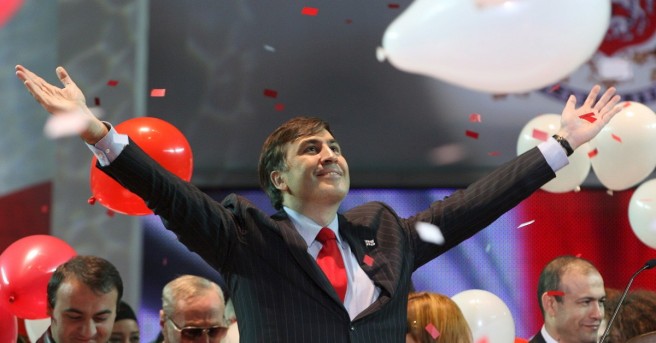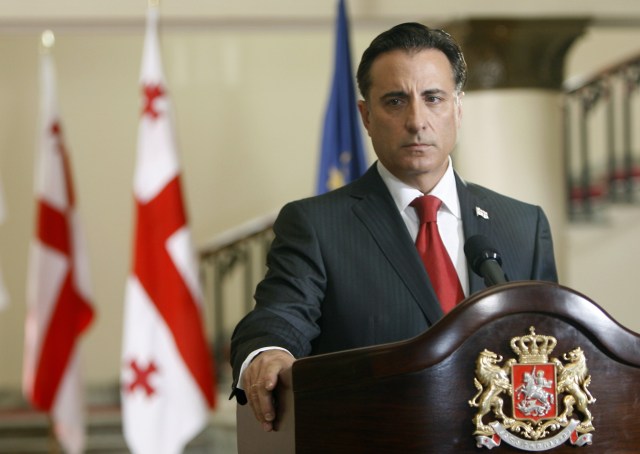He has been called a “real fighter against corruption” and a “political adventurer”. Many certainly remember him as the President of Georgia, an office which he held for 10 years. He was even interpreted by Andy Garcia in the movie “Five Days of War” (arguably not one of Hollywood’s greatest successes, but still…) But how did Saakashvili appear on the Ukrainian political horizon and why is he so vehemently opposed his recent friends and associates in the Ukrainian leadership?
Mikheil “Mikho” Saakashvili was born on December 21, 1967 – only a few days ago he celebrated his 50th birthday in Kiev. During the last years of the Soviet Union, he went to study in Kiev at the prestigious Institute of International Relations, which trained diplomats and staff of Soviet international institutions. Since then he has felt a special connection to Ukraine.
After graduation, he returned to Georgia, where in 1992 he began to work as a lawyer-consultant in the State Committee for Human Rights. In the same year, he received a grant from the US State Department and after a period in Strasbourg was sent to study at Columbia University (New York), where in 1994 he received a Master of Law.
A rapid political career
In 1995, Mikhail Saakashvili once again made it back home to Georgia at the personal invitation of his friend Zurab Zhvania, who then became chairman of the Georgian parliament. Zhvania died tragically in 2005 under unclear circumstances – according to the official version he suffocated with carbon monoxide because of a faulty gas heater.
In 1995, Mikheil Saakashvili, who had joined “Union of Georgian Citizens”, Zhvania’s and President Shevardnadze’s party, became a member of the parliament. By 2000 he was Minister of Justice, but one year later he had already resigned, accusing the government of corruption. Soon Saakashvili founded his own party, the United National Movement, and when the Presidential election was held in 2003, amid allegations of rigging, he played a key role in the ensuing protests.

“The Rose Revolution”
Thousands of protesters took to the streets, led by Saakashvili. This event was one of the first “color revolutions”. After two weeks of demonstrations, Shevardnadze finally stepped down and in the repeating of the election which took place in January 2004, Saakashvili was elected president with a stunning 96%, becoming the youngest leader among the former Soviet countries. Saakashvili tried to regain control over the “rebellious regions” by sending troops to South Ossetia in August 2004, but they had to retreat, having lost dozens of people. He also failed to subdue the rebellious Abkhazia. However, he managed to bring under control the rebellious Adzharia – a region in southern Georgia, which previously enjoyed broad autonomy and almost did not submit to the central government, gravitating more towards Turkey.
In other fields, the new President was more successful, conducting neo-liberal economic reforms, which later set an example for other post-Soviet countries, in particular, Ukraine. At first, Georgia’s GDP increased sharply, thanks to financial assistance from the IMF and Western countries, but in later years the growth rate fell sharply from 12.3% to 2.4%. Neo-liberal economists give Saakashvili credit for having liberalized the economy and reducing taxes for business.
By 2007, malcontent was growing in Georgia. This led to massive opposition protests in Tbilisi in November. Saakashvili ordered to disperse the protesters. As a result of tough police actions, 508 people were hospitalized. On the same day, the Georgian special police forces raided the office of the opposition channel Imedi TV.
War with Russia
Saakashvili offered early elections and was re-elected for a second term. Shortly thereafter, on the night of August 8, 2008, the Georgian troops again tried to regain control of the rebellious South Ossetia. As a result of artillery shelling of the Ossetian capital of Tskhinval, a significant part of the city was destroyed. Russia meddled in the conflict and after five days of fighting it forced out Georgian troops from South Ossetia. At the same time, Abkhaz rebels drove Georgian troops out of the Kodori Gorge, expanding their territory. The war ended quickly thanks to the diplomatic efforts of then President of France Nicolas Sarkozy, with Abkhazia and South Ossetia declaring independence (which is recognized only by a handful of countries) and remaining to this day out of the reach of the central government.

In December 2008, Saakashvili ordered to blow up a monument to Georgians who died during the Second World War in the city of Kutaisi. The decision caused protests in the city, so the authority decided to move quickly and to blow up the monument two days ahead of schedule, in order to avoid mass protests. As a result of a violation of safety precautions, accidental passers-by – a woman and her eight-year-old daughter – died, killed by splinters.
Goodbye, Lenin
Following the conflict with Russia Georgia withdrew from the CIS or Commonwealth of Independent States, the entity that was conceived as the heir of the Soviet Union, and announced its intention to join NATO. When the next parliamentary elections were held in Georgia, in October 2012 the opposition party “Georgian Dream – Democratic Georgia” received more than half of the seats in the Georgian parliament. The leader of the opposition bloc immediately announced that it was necessary to resume the investigation into the death of Zurab Zhvania, the Georgian Prime Minister.
A little later, reports began to appear that Saakashvili’s associates were leaving Georgia, afraid of prosecution by the opposition. The current Georgian leadership and his former ally Nino Burjanazze (chairman of the Georgian parliament under Saakashvili) are prosecuting Saakashvili for his “military adventure” that caused the death of many people. In 2014, the Prosecutor General’s Office of Georgia instituted a number of criminal cases against Saakashvili, including his abuse of authority and embezzlement of budget funds, after which the court in absentia arrested him and arrested the property of the ex-president. He is also charged with organizing an armed attack on MP Valery Gelashvili in 2005, concealing the crime, falsifying the investigation into the murder of banker Sandro Girgvliani in 2006 and embezzlement of public funds in 2009-2012.
In late October 2013, without waiting for the end of his presidential term, Saakashvili left Georgia and flew to Brussels. In December 2013, he became a teacher at the School of Law and Diplomacy at Tufts University and since 2014 he has been Chairman of the Board of Directors of the New International Leadership Institute based in Washington.
Governor in Odessa
In February 2015, a new adventure starts for Saakashvili, this time in Ukraine where he is appointed advisor to President Petro Poroshenko. On February 17, 2015, Georgia demanded that Saakashvili be extradited from Kiev, but the request was rejected. In May 2015, the former president of Georgia received Ukrainian citizenship and was appointed governor of the Odessa region, a troublesome region for the current Ukrainian leadership, especially following the bloody events of May 2, 2014.
US Ambassador to Ukraine Jeffrey Payette, while in Odessa, declared the support of the US State Department for Saakashvili in his fight against corruption, and that the Odessa region should become a “reform laboratory in Ukraine.” However, soon the former Georgian president and now governor of the Odessa region started to have conflicts with other figures of the Maidan elite. The most known accident was the public exchange of insults between Saakashvili and Interior Minister Avakov in October 2016 at a government meeting.
Odessa deputy of the Verkhovna Rada from the Bloc of Petro Poroshenko, Dmitry Golubov, complained of the “circus troupe of the racketeer Saakashvili” in the parliament, and said that the Odessa governor was engaged in racketeering and extortion: “Large enterprises and businessmen receive letters from his adviser with a request to provide charitable assistance in the amount of 2.5 million hryvnia”. And te mayor of Odessa Gennady Trukhanov called Saakashvili a paranoiac and said he must be prosecuted.
In November 2016, Saakashvili finally resigned from his new post, after a bare 18 months. Leaving the post of governor, he said that he had known the new US president for a long time and had flown to the inauguration of Donald Trump. On July 26 this year Ukraine deprived Saakashvili of the Ukrainian citizenship he had been granted only two years previously.
The Eternal Rebel
But it was not over for Saakashvili in Ukraine. Some Ukrainian publications were writing in the summer to expect a surprise from Saakashvili. On September 10, 2017, surrounded by supporters, among them Yulia Tymoshenko, he broke through the cordons of border guards and entered the territory of Ukraine again. Soon he announced the formation of a new political movement, which he called the “Movement of New Forces”, and then began organizing protests. Saakashvili calls his goal the removal of Poroshenko from power and the “fight against corruption.”
At the moment, Saakashvili, who boast of having the support of Western diplomats in Ukraine, can not count on becoming the president of Ukraine, because he has lost his Ukrainian citizenship. But that might turn out to be a legal irrelevant formality at some point. Ukrainian politicians perceive him as a “battering ram”, with the help of which it is possible to clear the way for others. The most likely leader of the future presidential race could be former Prime Minister Yulia Tymoshenko, who is actively joining in for Saakashvili, criticizing the president. At the same time, some politicians and experts call Saakashvili only an instrument of pressure from the US, and not an independent politician. With his help, the US leadership seems to be trying to control the Ukrainian president, forcing him to act not in the interests of his own circle, but to be the executor and conductor of US interests in the region. Mikheil Saakashvili himself has nowhere to go – facing charges which include homicide, torture and financial fraud in his home country. He just has to play the game.
One thought on “Who is Mikheil Saakashvili and what does he want in Ukraine?”